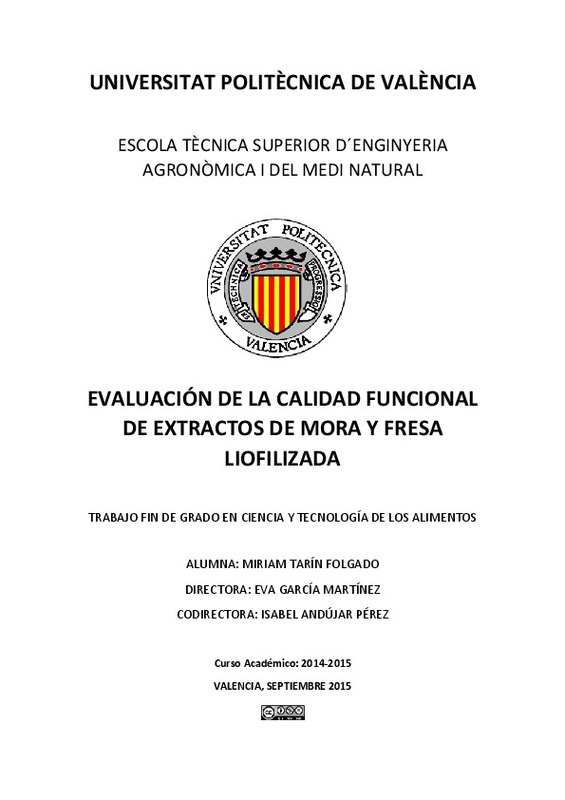JavaScript is disabled for your browser. Some features of this site may not work without it.
Buscar en RiuNet
Listar
Mi cuenta
Estadísticas
Ayuda RiuNet
Admin. UPV
Evaluación de la calidad funcional de extractos de mora y fresa liofilizada
Mostrar el registro sencillo del ítem
Ficheros en el ítem
| dc.contributor.advisor | García Martínez, Eva María
|
es_ES |
| dc.contributor.author | Tarín Folgado, Miriam
|
es_ES |
| dc.date.accessioned | 2015-10-05T15:35:23Z | |
| dc.date.available | 2015-10-05T15:35:23Z | |
| dc.date.created | 2015-09-09 | |
| dc.date.issued | 2015-10-05 | es_ES |
| dc.identifier.uri | http://hdl.handle.net/10251/55561 | |
| dc.description.abstract | [ES] Dentro de las frutas, la mora y la fresa, se consideran una importante fuente de compuestos fenólicos y otras sustancias antioxidantes. En este sentido, son ampliamente conocidas sus propiedades beneficiosas para promover la salud, jugando un papel esencial en la prevención de ciertas enfermedades relacionadas con el daño oxidativo. Se han demostrado muchas propiedades beneficiosas de los polifenoles, como su actividad antioxidante, antiinflamatoria o anticarcinogénica, entre otras. Sin embargo, ambas frutas son un recurso marcado por la estacionalidad de su cultivo y por una escasa vida útil, asociado a su alto contenido en agua, lo cual limita su disponibilidad. Con el fin de aumentar la vida útil, la industria agroalimentaria está aplicando en los últimos años tecnologías que permitan obtener alimentos en polvo de gran calidad, como es el caso de la liofilización. El uso de estas frutas en su forma liofilizada podría ser una buena estrategia para la obtención de alimentos funcionales ricos en compuestos antioxidantes. En este estudio se trabajará con mora y fresa frescas y liofilizadas con y sin la adición de goma arábiga como coadyuvante tecnológico. Se estudiará el efecto de la liofilización y de la adición de este soluto sobre los principales compuestos bioactivos y actividad antioxidante de dichas frutas. Para ello se extraerán y cuantificarán los principales compuestos bioactivos liposolubles e hidrosolubles y se analizará la actividad antioxidante de cada uno de los extractos obtenidos. Además se realizarán ensayos in vitro de citotoxidad en una línea celular de macrófagos murinos y se evaluará la posible actividad antiinflamatoria de los extractos estudiando la inhibición de la producción de ácido nítrico. | es_ES |
| dc.description.abstract | [EN] Amongst the fruits, mulberry and strawberry are considered an important source of phenolic compounds and other antioxidants. In this sense, they are widely known for their beneficial health attributes, they play an essential role in preventing some specific diseases related with oxidative damage. These fruits have shown many beneficial properties due to the presence of polyphenols as antioxidants, anti-inflammtory or anticarcinogenic activity amongst others. However, both fruits are a resource marked by the seasonality of their cultivation and their short shelf life, associated with its high water content which limits their availability. In order to increase the shelf life, the food industry applies technologies to obtain high quality food powder, such as freeze drying. The use of these freeze dried fruits may be a good strategy to obtain functional foods rich in antioxidant compounds. This study has evaluated the effect of freeze drying and the addition of arabic gum (1.2%) on the main bioactive compounds (phenols and carotenoids) and antioxidant activity of strawberry and mulberry. The results show that freeze drying appears to be a good alternative to obtain a powder product with a high content of bioactive compounds. Mulberry had higher content of bioactive compounds and antioxidant activity than strawberry. Processing the strawberry didn’t caused significant changes in the phytochemical content, while in the blackberry caused losses in phenols. In general, the addition of arabic gum as technological additive favored stability of the studied phytochemicals, showing encapsulant and protective action, and improving the antioxidant activity of the product powder. Moreover, in vitro cytotoxicity assays were performed in a murine macrophage cell line and the inhibition of nitric oxide production in hydrophilic extracts of mulberry and strawberry freeze-dried with and without solutes was evaluated. We observe that solute-free extract showed inhibitory activity of nitric oxide production, but this activity was not observed in the extracts of the samples with Arabic gum. | es_ES |
| dc.language | Español | es_ES |
| dc.publisher | Universitat Politècnica de València | es_ES |
| dc.rights | Reconocimiento - No comercial - Sin obra derivada (by-nc-nd) | es_ES |
| dc.subject | Fresa | es_ES |
| dc.subject | Mora | es_ES |
| dc.subject | Liofilización | es_ES |
| dc.subject | Actividad antiinflamatoria | es_ES |
| dc.subject | Actividad antioxidante | es_ES |
| dc.subject | Strawberry | es_ES |
| dc.subject | Mulberry | es_ES |
| dc.subject | freeze drying | es_ES |
| dc.subject | Arabic gum | es_ES |
| dc.subject | phytochemicals | es_ES |
| dc.subject | Anti-inflammatory | es_ES |
| dc.subject | Antioxidant activity | es_ES |
| dc.subject.classification | TECNOLOGIA DE ALIMENTOS | es_ES |
| dc.subject.other | Grado en Ciencia y Tecnología de los Alimentos-Grau en Ciència i Tecnologia dels Aliments | es_ES |
| dc.title | Evaluación de la calidad funcional de extractos de mora y fresa liofilizada | es_ES |
| dc.type | Proyecto/Trabajo fin de carrera/grado | es_ES |
| dc.rights.accessRights | Abierto | es_ES |
| dc.contributor.affiliation | Universitat Politècnica de València. Escuela Técnica Superior de Ingeniería Agronómica y del Medio Natural - Escola Tècnica Superior d'Enginyeria Agronòmica i del Medi Natural | es_ES |
| dc.contributor.affiliation | Universitat Politècnica de València. Departamento de Tecnología de Alimentos - Departament de Tecnologia d'Aliments | es_ES |
| dc.description.bibliographicCitation | Tarín Folgado, M. (2015). Evaluación de la calidad funcional de extractos de mora y fresa liofilizada. http://hdl.handle.net/10251/55561. | es_ES |
| dc.description.accrualMethod | TFGM | es_ES |
| dc.relation.pasarela | TFGM\33858 | es_ES |
Este ítem aparece en la(s) siguiente(s) colección(ones)
-
ETSIAMN - Trabajos académicos [3541]
Escuela Técnica Superior de Ingeniería Agronómica y del Medio Natural






